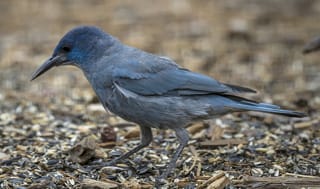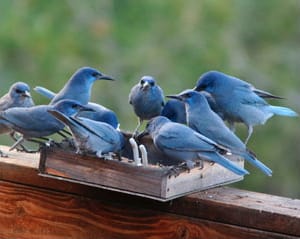Initially this guide displays common birds of all types that are flying right now in our area. Use the selectors below to view rare birds, view birds flying any time, restrict the output to a certain shape of bird, or search by name.
New Mexico is on the western edge of the Central Flyway which is one of the major migration pathways between north and south for birds traveling between breeding and wintering grounds along the Rocky Mountains. This has resulted in the state having an incredible diversity of birds with over 550 different species reported. A little more than half of this number are sighted annually on the Pajarito Plateau. Some of these birds are full-time residents, some migrate here for a few weeks or months, and other are only seen briefly as they pass through the region.
This guide features many of the birds known to frequent Los Alamos county by when they are likely to be seen in the area. You can get additional information on local birds by joining PEEC Birders or going to the eBird website. eBird also includes lists of rare bird sightings and birding hot spots.
Bird References
Birdweb
Cornell Lab of Ornithology
eBird
eNature
Institute for Bird Populations
National Audubon Society
New Mexico Ornithology Society
What Bird
xeno-canto
Subject Area Experts (all guides)
Steve Cary (butterflies)
Beth Cortright (insects)
Terry Foxx (invasive plants)
Leslie Hansen (mammals)
Richard Hansen (fish, mammals)
Dorothy Hoard (butterflies, trees)
Chick Keller (flowers, herbarium)
Shari Kelley (geology)
Kirt Kempter (geology)
Garth Tietjen (reptiles)
David Yeamans (birds)
Web Development and Content Management
Pat Bacha
Jennifer Macke
Graham Mark
Akkana Peck
Contact
Please contact us for local nature questions and sightings. We welcome comments, corrections, and additions to our guides.
For more information about local nature, please visit our Nature Blog or subscribe to PEEC This Week.
Make Selection
 Photo: adult by Mouser Williams  Photo: small group of adults by Hari Viswanathan |  Pinyon JayPIJA (Gymnorhinus cyanocephalus, Cyanocephalus cyanocephalus)Family: Corvidae (Jays, Magpies, and Crows) Size: 9 - 11 in (23 - 28 cm) Flies: Jan 01 - Dec 31 Morphology: both sexes are dull blue with white chin, short tail, and long bill; immatures are similar to adult but duller in color Status: native; locally common Food source: seeds (especially those from the pinyon pine), fruits, insects, and sometimes eggs Habitat: ponderosa pine, pinyon-juniper, mixed pine oak forests Typical location: White Rock Spectacularly colorful and noisy flocks arrive in the summer. Pinyon Jays primarily forage on the ground but can clean out a bird feeder in no time. Flocks tend to follow the pinyon crop. They store the nuts in late summer and early fall by burying them in the ground for later retrieval. Social organization among these jays is complex with overall permanent flocks that can reach several hundred in size. The birds nest in colonies in cup-shaped nests found high up in juniper, oak, and pinyon trees. Incubation time is a little less than 3 weeks with the young leaving the nest about 3 weeks after that. Info Photos Distribution Frequency |
